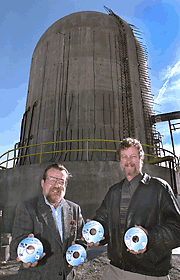|

Sandia National Laboratories researchers Randy Cole (left) and Randy Gauntt with copies of MELCOR 1.8.5. Behind them is a 1/4-scale model of a pre-stressed concrete containment vessel used by Sandia recently to gather the type of experimental data about nuclear power reactors that MELCOR factors in when it models the progression of a severe accident at a power plant. (Photo by Randy Montoya)
Download 300dpi JPEG image, ‘melcor.jpg’, 1.4MB (Media are welcome to download/publish this image with related news stories.)
|
Sandia accident-modeling software to help
improve tomorrow’s nuclear power safety regs
ALBUQUERQUE, N.M. — Researchers at the U.S. Department of Energy’s Sandia National Laboratories have released updated computer software that models the complex physical phenomena that occur as a nuclear power plant accident progresses through time.
The software, distributed on a compact disk, incorporates the results of 20 years of nuclear power plant safety research since the 1979 accident at Three Mile Island.
By using the latest experimental data available, MELCOR 1.8.5 can help regulators and utilities more sensibly define their operational margins of safety and minimize the burden of unnecessary regulation on the nuclear power industry, says Sandia project leader Randy Gauntt.
“It will allow them to revisit some of the perhaps overly conservative regulations and identify areas where no safety enhancements are gained, then refocus on areas where greater safety precautions might make a difference,” he says.
MELCOR models the whole power plant, from the cooling-system plumbing and control wiring to the physical interactions between nuclear fuel rods and their containment vessels.
To use MELCOR, the user defines details such as the plant’s design and equipment, as well as any predetermined operator actions, then specifies an initiating event — such as a rupture in a cooling-system pipe or a power outage. MELCOR does the rest, calculating a mathematical play-by-play summary of the accident.
Sandia began developing MELCOR in 1982, with its first full release in 1989. Since then, four updated versions have been released as the code’s capabilities have improved. The U.S. Nuclear Regulatory Commission (NRC) endorsed version 1.8.5 in May. Late last month 40 copies of MELCOR 1.8.5 were sent to interested utility companies and regulators in the U.S. and abroad.
Previous versions of MELCOR are among the standard tools being used by U.S. and overseas utilities and nuclear regulators to evaluate the adequacy of plant safety, says Gauntt.
Sandia is a multiprogram laboratory operated by Sandia Corporation, a Lockheed Martin Company, for the United States Department of Energy under contract DE-AC04-94AL85000. With main facilities in Albuquerque, N.M., and Livermore, Calif., Sandia has major research and development responsibilities in national security, energy and environmental technologies, and economic competitiveness.
Media contact:
John German, jdgerma@sandia.gov, (505) 844-5199
For more information about other recent Sandia nuclear energy-related R&D, see:
Sandia pushes nuclear vessel model until it 'pops'
Sandia to pressurize scale model of nuclear reactor containment vessel until it fails
Major issue impeding successful magnetic confinement fusion resolved by joint Sandia/General Atomics/UC-San Diego research
| 